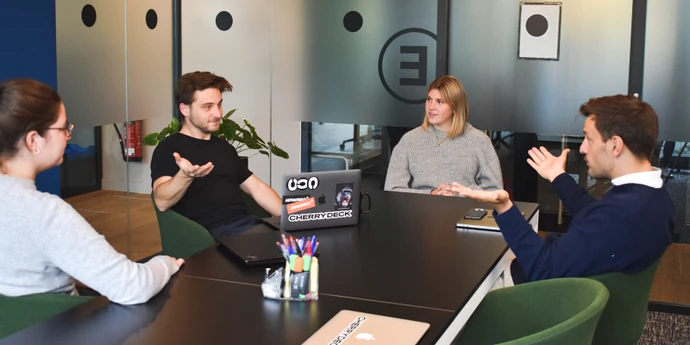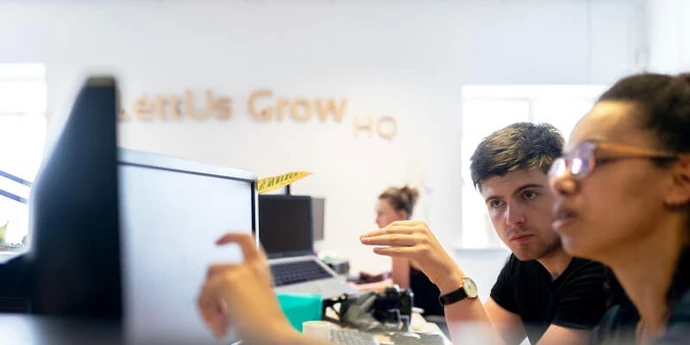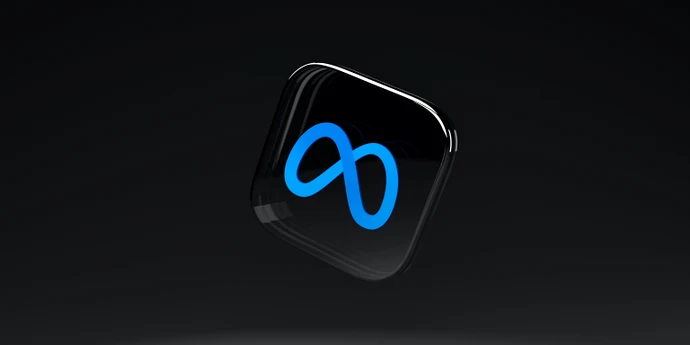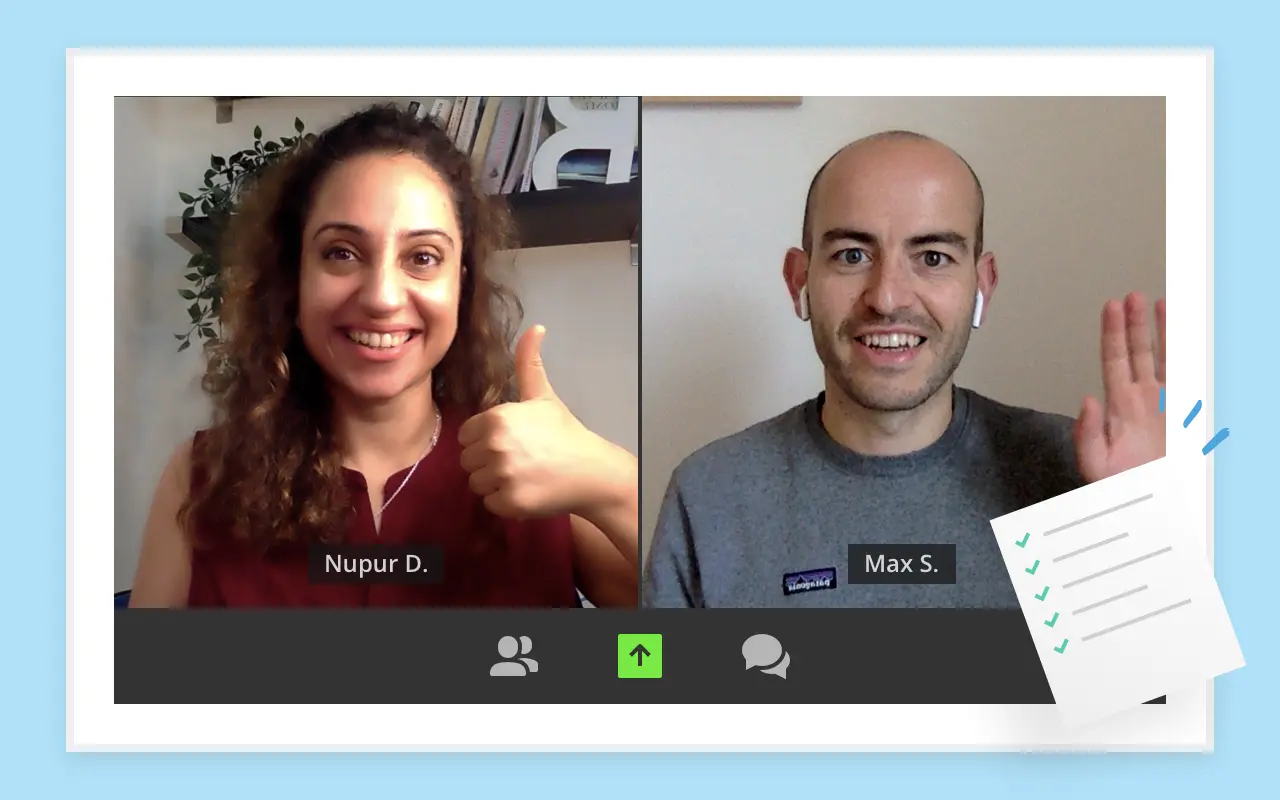Anthropic's interview process is challenging, fast-moving, and opaque in parts. But without knowing what's ahead, it's even harder to prepare as a candidate.
This guide walks you through exactly what to expect at each stage of Anthropic’s interview process and how to prepare for it. We've researched dozens of real candidate reports and other trusted sources to understand what the company actually looks for, and we've distilled that into actionable strategies for each round.
Here's an overview of Anthropic's full interview process:
- Step 1: Recruiter call
- Step 2: Online assessment
- Step 3: Hiring manager screen
- Step 4: Technical interview loops
- Step 5: Reference checks & team matching
- Step 6: Offer & negotiation
Before we dive into each step, let's get to know Anthropic.
Click here to book 1-on-1 interview coaching with an ex-Anthropic interviewer.
1. About Anthropic ↑
Anthropic is one of the most talked-about companies in artificial intelligence today, and for good reason. Anthropic was built around a single big idea: that AI should be powerful, but also safe, interpretable, and under meaningful human control.
The company’s founding team left OpenAI after growing concerns about how quickly AI systems were scaling and how little was understood about their inner workings. That ethos still defines Anthropic’s culture and mission.
The company operates with a mission-first culture and a team spanning physics, machine learning, public policy, and business backgrounds. Anthropic is transparent about its hiring philosophy, too: it values diverse backgrounds over traditional credentials (as you’ll see in the next section).
2. Working at Anthropic ↑
To understand what Anthropic looks for in candidates, you need to understand how the company operates.
2.1 Mission-first culture
Anthropic’s north star is AI safety. The company’s entire structure (how it sets goals, how it prioritizes work, and even how it hires) flows from that.
In interviews, this shows up as questions about how you make decisions under uncertainty, how you weigh risk, and whether you think about long-term consequences. You don’t need to be an AI safety expert, but you do need to care about what you’re building.
2.2 High-trust, low-ego organization
Anthropic describes itself as "high-trust" and "low-ego." This translates to direct, honest communication and an expectation that everyone (regardless of role) will contribute beyond their title.
As Anthropic’s values state, "If something urgently needs to be done, the right person to do it is probably you!"
This creates a culture where there's less rigid hierarchy than at traditional tech companies. Your seniority matters less than your ability to solve problems and your willingness to take ownership.
2.3 Diverse technical paths
Anthropic is genuinely open to diverse backgrounds. The company stated that roughly half its technical staff come from non-ML backgrounds, suggesting diverse educational paths.
They value "direct evidence of ability" over credentials. If you have an interesting GitHub project, a strong blog post, or open-source contributions, that matters more than your educational background.
This also means if you're applying as an engineer with strong systems knowledge but no ML background, you're encouraged to apply. The interview process is designed to assess whether you can learn and contribute, not whether you tick specific boxes.
2.4 Pragmatic engineering culture
Anthropic believes in keeping things simple and effective. One of their values explicitly says: "We don't invent a spaceship if all we need is a bicycle."
This culture comes through in interviews, too. They're not looking for the most algorithmically elegant solution. They want working code, clear reasoning, and practical tradeoffs. If a simple loop solves the problem, that's better than an over-engineered solution.
3. Anthropic's seven core values ↑
To prepare for Anthropic, you should deeply understand their values, as they directly inform the interview process and culture fit assessment.
Anthropic’s 7 Core Values
1. Act for the global good. Anthropic makes decisions to maximize positive outcomes for humanity in the long term, even when it requires bold action. They take their role in safely guiding the world through an AI revolution seriously.
2. Hold light and shade. AI has unprecedented upside and downside potential. Understanding both the risks and benefits is necessary. You need "shade" to protect against bad outcomes and "light" to realize good ones.
3. Be good to our users. Users here include not just customers, but also policymakers, fellow Ants (Anthropic employees), and anyone affected by our technology. We hold ourselves to a standard of generosity and kindness in every interaction.
4. Ignite a race to the top on safety. Safety is Anthropic’s competitive moat. They want to inspire other AI developers to compete on safety and security.
5. Do the simple thing that works. Anthropic values clarity over complexity. When faced with multiple solutions, they choose the straightforward approach that delivers results, avoiding unnecessary sophistication that can slow progress.
6. Be helpful, honest, and harmless. Being helpful means creating genuine value, being honest means communicating transparently about capabilities and limitations, and being harmless means carefully considering potential negative impacts.
7. Put the mission first. Everything else flows from the mission. Personal ownership over mission success is expected.
4. Anthropic interview process and timeline ↑
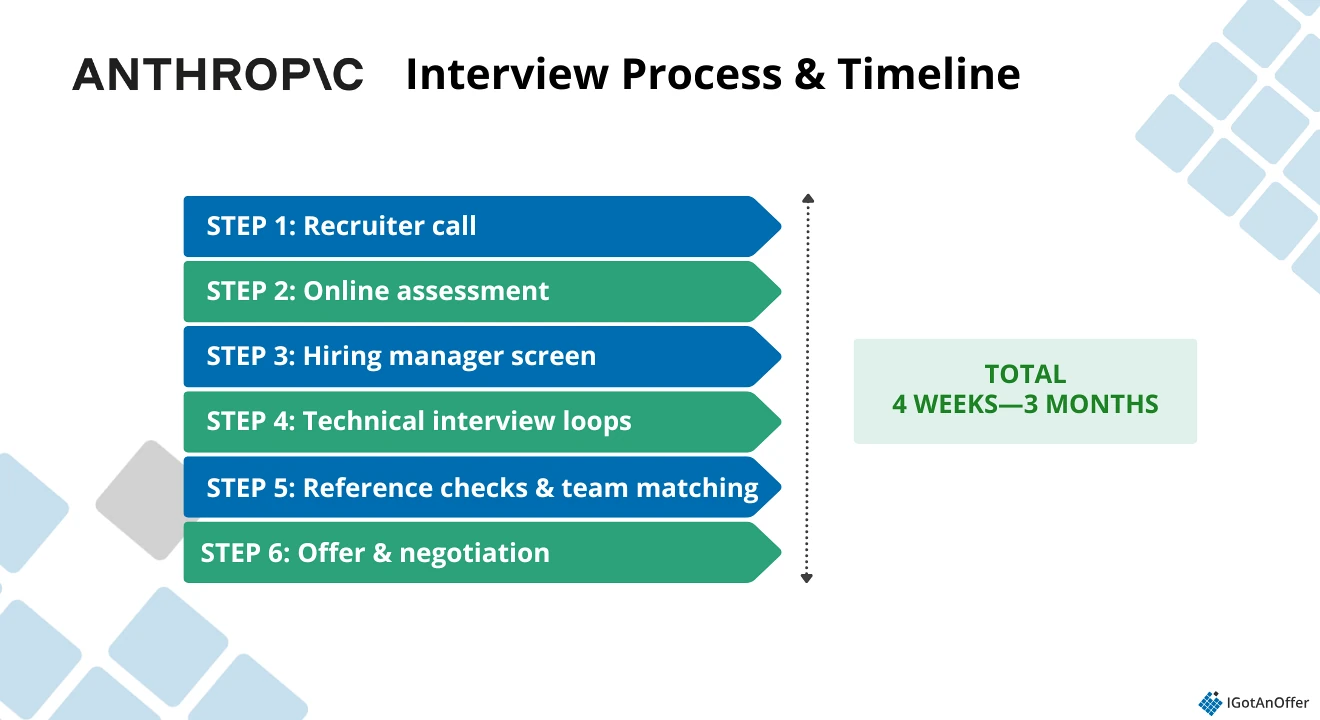
The Anthropic interview process typically takes 4 weeks to 3+ months, depending on factors like team matching and reference check timing. The steps can vary by role, but most candidates go through these main stages:
- Recruiter call (30 minutes)
- CodeSignal online assessment (90 minutes)
- Hiring manager screen (1 hour)
- Technical interview loops (4-5 rounds, 55 minutes each)
- Reference checks & team matching (variable, 2-4+ weeks)
- Offer & negotiation
Your recruiter may clarify your specific process during the initial call.
Step 1: Recruiter call ↑
Your first interaction after your application is accepted will be with a recruiter from Anthropic's talent team. If you applied directly through Anthropic's careers portal, applied through an employee referral, or were contacted directly by a recruiter, this call is your next step.
The recruiter's job is to confirm that your background is relevant to the role and that you're genuinely interested in Anthropic before the company invests significant time in technical assessments. It's usually just a conversation designed to assess cultural fit and clarify expectations on both sides.
During this call, expect questions like:
- “Tell me about yourself.” (Keep it to 2-3 minutes, focusing on relevant experience.)
- “Why Anthropic specifically?” (Reference specific things about their mission, their approach to safety, their values, or specific products.)
- “Why this role?” (Explain what about this specific position appeals to you and why you think you'd be good at it.)
- “Walk me through your resume.” (Be ready to discuss key projects and technical decisions.)
- “What are your career goals? Where do you want to go in 3-5 years?” (Be specific about skills you want to develop or impact you want to have, while demonstrating you've thought about how this role fits into your broader career arc.)
Go with your own questions, too. Ask about the team, the work, and the culture. A candidate who asks thoughtful questions signals genuine interest, which matters at a mission-driven company like Anthropic.
This is also your opportunity to clarify the interview process. Ask your recruiter how many rounds you'll face, what each one focuses on, and timeline expectations.
If you're not from an ML background, this is a good moment to mention it and ask whether that's a concern for the role. Anthropic says it’s not an issue, but it’s still helpful to hear what your recruiter thinks.
If the conversation goes well and the recruiter believes you're a fit, they'll send you a CodeSignal link for an online assessment within a few days, along with instructions and a timeline (typically 5-7 days to complete it).
Step 2: Online assessment ↑
The online assessment at Anthropic is usually CodeSignal. It’s Anthropic's automated filter for technical roles. You’ll face a single complex problem divided into 4 levels, and you have 90 minutes to solve it.
Here's how it works:
- Level 1 presents a problem with a set of unit tests. You write code to pass those tests and, once you do, level 2 unlocks.
- Each subsequent level builds on the previous one. You're typically modifying and extending code you already wrote.
- Each level progressively increases in complexity and tests your ability to adapt code to new requirements.
- You can see all the unit tests for each level.
You should write code that actually solves the problem. Anthropic uses LLMs to detect code that's specifically engineered to pass tests rather than solving the problem genuinely.
Over the past few months, we’ve seen a pattern in the types of CodeSignal problems candidates face. They’re designed to test:
- Your ability to write clean, modular code that scales
- How you approach incrementally increasing complexity
- Whether you can think about performance and edge cases
- Your overall problem-solving process
For example, you'll likely encounter problems that require building an in-memory key-value database (starting with simple SET, GET, and DELETE commands, then expanding to filtered scans, TTL timestamps, and file compression), develop a scalable banking system, implement a constrained file cache, or simulate a cloud database.
A strong CodeSignal score is necessary but not sufficient for progression. Several candidates on Glassdoor have reported near-perfect scores (590–600) and still didn’t advance. This suggests that the CodeSignal score is evaluated holistically alongside your resume, experience, and references. If you pass the threshold, other factors matter more.
While we've heard anecdotal reports of candidates with high CodeSignal scores not advancing, the specific reasons aren't always clear.
Still, your prep should reflect that same principle: go deep, not wide. Master Python’s syntax, libraries, and idioms so you can think in the language rather than translate into it. Practice problems that build progressively rather than randomly. LeetCode is a good tool for this, but choose problems that require layering complexity over time.
During the test, we recommend that you:
- Budget 20–25 minutes per level.
- Test as you go and debug incrementally. It's much faster to catch small issues early than to untangle them all at the end.
- If you get stuck, move on and circle back if time allows.
- The early levels are intentionally simple, so build something that works, then let complexity unfold naturally as the levels advance.
If you pass, you’ll typically receive an email within one to two weeks inviting you to the next stage: the hiring manager screen. If not, you’ll get an automated rejection and can reapply after 12 months, or sooner if your skills or experience have significantly evolved.
Step 3: Hiring manager screen ↑
This round is a technical deep dive into your background and thinking, not another coding interview.
The hiring manager is assessing whether you deeply understand your own work, how you approach problems and make technical decisions, whether you understand the role and can articulate why you want it, and whether you'd work well with their team. They're also starting to assess cultural fit in the context of your experience.
Expect to spend most of the conversation talking through your background in detail. They’ll ask you to walk through your career step by step. When you describe a project, they’ll dig deeper:
- Why did you make that decision?
- What were the tradeoffs?
- What would you do differently now?
- Did the solution work, and how do you know?
We recommend choosing two or three projects for a deep dive. Preferably ones where you can explain the full lifecycle: the problem, your reasoning for specific technical choices, the constraints you faced, how the system performed, and what you learned. Practice articulating these in a way that shows both technical depth and reflective thinking.
Also, if you don’t come from a machine learning background, don’t try to hide it. Own your story. Be ready to explain how you got here: what sparked your interest in AI, how you’ve been learning, and what unique perspective your background brings. Anthropic values diverse experiences, and many of its engineers transitioned from other fields.
The hiring manager conversation is usually friendly and collaborative. They’re genuinely interested in your work, even if they sometimes seem rushed or distracted. Don’t let that throw you off.
If you pass this stage, you’ll move on to the technical interview loop, typically scheduled within one to two weeks.
Step 4: Technical interview loops ↑
Each interview focuses on a different technical dimension, with a typical loop including:
- Live coding interview
- System design interview
- LLM & prompt engineering interview
- Culture fit or research brainstorming interview
The rounds are distinct, but together they assess the same core qualities: your ability to reason clearly, design robust systems, and make thoughtful tradeoffs.
1. Live coding interview
The first technical round focuses on practical problem-solving.
You'll receive a real-world problem and be expected to write code from scratch in a shared environment (Google Colab or Replit), run and debug it, discuss your approach and tradeoffs, and think out loud about edge cases and potential improvements.
Unlike typical algorithmic challenges, these problems are grounded in real engineering work.
Anthropic interviewers are looking for engineers who can start simple, iterate thoughtfully, and debug methodically. They care less about cleverness and more about clarity.
A good way to prepare for this round is to practice on shared environments like Google Colab or Replit, not in your local IDE.
Example live coding interview questions asked at Anthropic
- Parse all URLs from a list and count matches for a given domain (with follow-ups about asynchronous design and scaling).
- Scale a token-generating function to handle 100,000 requests per second (testing throughput, distributed latency, and pragmatic design).
- Implement a simple key-value store with evolving constraints around persistence and compression.
Learn more about how to get better at coding interviews here.
2. System design interview
The second technical round focuses on designing large-scale distributed systems. They're LLM-specific and very technical.
In system design interviews, they are assessing whether you understand distributed systems fundamentals, can think through scaling challenges, understand LLM-specific issues, identify potential bottlenecks, know when to use different technologies and why, and can discuss tradeoffs rather than just proposing solutions.
Example system design interview questions asked at Anthropic
- Design systems like:
- A distributed search system capable of handling 1 billion documents and 1 million queries per second, including LLM inference
- A hybrid search system combining traditional text retrieval with semantic similarity
- A data indexing pipeline for ingesting and indexing a billion documents with concurrent crawling
- A performance debugging scenario (e.g., a system's 95th percentile latency spiked from 100ms to 2000ms, how would you investigate and fix it?)
Dive deeper into system design interview questions here.
3. LLM & prompt engineering interview
The third technical round focuses on working practically with LLMs. You'll work on a problem involving LLMs, typically in Google Colab.
Interviewers want to see that you understand how LLMs work, where they fail, and how to design around those limitations.
Example LLM & prompt engineering interview questions asked at Anthropic
- Design effective prompts for specific use cases and think through the systematic approach to prompt engineering
- Build systems that call LLM APIs efficiently (managing tokens, handling rate limits, thinking about cost models)
- Design multi-step reasoning systems where multiple LLM calls work together.
4. Culture fit/research brainstorming interview
The final round shifts focus from what you know to how you think.
This round assesses whether your values align with Anthropic's mission and approach, you can think about long-term impact, you consider downside risks and potential harms, you're intellectually curious and thoughtful, and you'd be a good cultural fit with the team.
Example culture fit/research brainstorming questions asked at Anthropic
- Walk through a past project you’re proud of and discuss your decisions
- Reflect on tradeoffs between long-term and short-term choices.
- Brainstorm solutions in an open-ended AI problem space.
- Share your motivations and how you think about risk, ethics, or impact.
- Describe a time when you had to make a difficult ethical decision at work.
- Talk about a time when you disagreed with your team and how you handled it.
Check out our guide to behavioral interviews to find more questions to practice with, and an answer method that works.
Step 5: Reference checks & team matching ↑
After you pass your technical interviews, Anthropic moves into two parallel processes: reference checks and team matching.
You'll be asked to provide names and contact information, and you should notify your references to expect contact. Anthropic will reach out to them directly and ask about your technical abilities, reliability and follow-through, how you collaborate with others, and specific examples of your work. Choose references who know your work well and can speak specifically about projects and impact, not just general praise.
At Anthropic, the team matching process is to find an open role that fits your skills and experience. If there’s a clear fit, you’ll move toward an offer. If not, the process can stall, even if you passed every technical round.
This is the point where many candidates describe the process as the “most opaque”. Communication can slow down considerably. It’s common for this stage to take anywhere from two to four weeks, sometimes longer.
Note: Some candidates report hearing nothing for 10–14 days at a time; others receive occasional check-ins but no clear timeline.
That said, you can (and should) stay proactive. If you haven’t heard back within 7–10 days of submitting your references, it’s reasonable to send a polite follow-up.
Step 6: Offer & negotiation ↑
If you pass team matching and a team wants you, your recruiter will contact you to discuss the offer. They'll walk through compensation (salary, equity, bonus if applicable), discuss your start date and logistics, and discuss visa sponsorship if needed.
Anthropic's packages are comparable to Meta roles at similar levels. You can expect a mix of base salary and equity, plus benefits like comprehensive health coverage (for you and dependents), 22 weeks of paid parental leave, flexible PTO, and a $500/month wellness and time-saver stipend.
While your offer may look top band, you don't have to accept the first one. Anthropic expects candidates to negotiate. Come prepared with market data, know your value, and back your ask with specifics.
Salary negotiation is where many strong candidates leave money on the table. Here's how to approach it:
Salary negotiation tips
- Be polite: Remember that the person you’re negotiating with is just doing their job, and that the two of you are not enemies. You’ll get much further in your negotiations if you approach the conversation with grace.
- Don’t give a number right away: Whenever possible, it’s better to wait until you receive an offer to start negotiating. This reduces the risk of giving a number that is lower than what the company otherwise would have paid, or giving a number that is so high that they'll be reluctant to interview you.
- Do your research: Have a number in mind before the conversation begins, and back it up with data. Research your position and level on Levels.fyi, ask around on professional social networking sites like Blind, factor in the cost of living where you are, and, ideally, get some input from a current Anthropic employee.
- Start high: To start the conversation, name a compensation number that is higher than your goal, and the Anthropic negotiator will likely end up negotiating it down to a number that is closer to your original goal.
- Negotiate everything: Your offer will include more than a base salary and stock options. You also have bonuses, vacation days, location, work from home, and other aspects to consider. If the salary won’t budge, there may be some wiggle room around the other perks.
For even more salary negotiation tips, check out our product manager job offer negotiation guide. It’s written for PMs, but the principles apply across roles.
Once you’re ready to put your negotiation skills to the test, get salary negotiation coaching from ex-FAANG recruiters so you can practice with and get instant feedback from a real expert.
5. Are you prepared for your Anthropic interviews? ↑
We've coached more than 15,000 people for interviews since 2018. In our experience, practicing real interviews with experts who can give you company-specific feedback makes a huge difference.
Find an Anthropic interview coach so you can:
- Test yourself under real interview conditions
- Get accurate feedback from a real expert
- Build your confidence
- Get company-specific insights
- Learn how to tell the right stories, better
- Save time by focusing your preparation
Landing a job at a leading AI company like Anthropic often results in significant career growth and the opportunity to work on transformative problems. Three or four coaching sessions worth ~$500 make a great difference in your ability to land the job.
Click here to find an ex-Anthropic interviewer.
6. Frequently asked questions about the Anthropic interview process ↑
What if I don't have ML experience?
Anthropic welcomes people without ML backgrounds. About half their technical staff don't have prior ML experience. If you're applying:
- Highlight your engineering fundamentals
- Demonstrate ability to learn
- Show curiosity about the domain
Your non-ML background might actually be an advantage as you bring a fresh perspective.
What if I get rejected?
You can reapply after 12 months. Alternatively, if something materially changes about your experience or skills (you built something significant, published research, etc.), you can reapply earlier with a stronger application.
Anthropic does not provide feedback on rejections, whether during CodeSignal, interviews, or team matching. This is a limitation of their process, not a reflection on you.
Should I use AI tools to prepare?
Anthropic's careers page includes a policy on AI usage in the application process. The summary: You can use AI for brainstorming, refining your thinking, and general preparation. Don't use it to generate code solutions for CodeSignal or during interviews.
Will they sponsor my visa?
Yes, Anthropic sponsors visas. While they can’t do so for every role or candidate (operations roles, for example, are especially difficult to support), they make every effort to help technical hires relocate. If you receive an offer, Anthropic will retain an immigration lawyer to assist with the process and guide you through every step of getting to the US.







